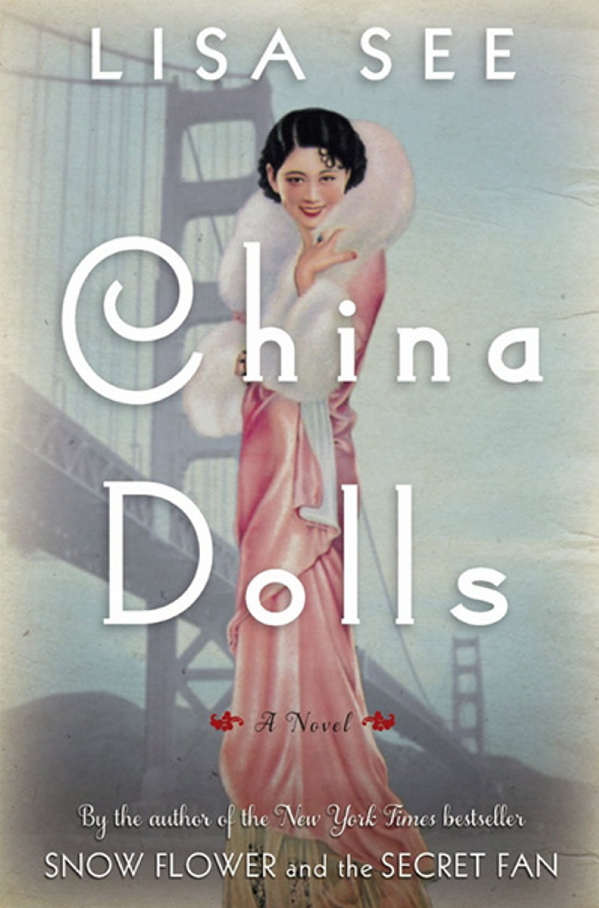Lisa See’s ambitious novel, “China Dolls,” spotlights the under-told story of Asian American entertainers during the 1930s and 1940s. See’s eight previous books have explored Chinese American experiences, and she offers the perfect summer read in this flamboyant, historical novel.
“China Dolls” is packed with engaging period details about fashion, food, film and music, and also addresses serious gender and geopolitical issues.
Grace Lee, Helen Fong and Ruby Tom meet in the late 1930s in San Francisco. Estranged from their families, they venture into the glamorous world of nightclub performance. See writes in the distinct, alternating voices of the three friends as they delight in their new independence yet also face battery, unexpected pregnancy and imprisonment.
Grace Lee grows up in Plain City, Ohio, where her parents have fled prejudices experienced in California. But Mr. Lee feels unmanned by his laundry job and vents his rage by battering his wife and daughter.
“My forehead had healed completely, but the inside of my skull continued to swim from being banged against the kitchen floor,” Grace recalls. “The skin over my ribs was mottled green, gray and purple. My shoulder felt swollen and stiff from being dislocated then jammed back into place, but the cut on my lip had nearly disappeared.”
After escaping to San Francisco, Grace gets thoroughly lost and finds her bearings with the help of a decorous young woman named Helen. Helen lives with her extended family and works at the Chinese Telephone exchange. She says: “I couldn’t face another day of listening to other women talk between calls about what they were going to make for dinner that night for their husbands, how clever their children were or how hard it was to make ends meet.”
While auditioning to be dancers at the Forbidden City nightclub, they meet stunning Ruby from magical Hawaii, whose parents want her to come home. Ruby says: “Beat it while the beating is good. But I told my pop I love glitter. I told him I want to be famous.”
Grace and Helen land dancing gigs at the Forbidden City, performing alongside the Merry Mahjongs, the Lim Sisters, the Forbidden Knights and Eddie Wu, the Chinese Fred Astaire. Ruby joins Sally Rand’s troupe at the Golden Gate International Exhibition. Before long, she reveals her true identity: Kimiko Fukotomi. She’s not Chinese, it turns out, but Japanese – a significant distinction in wartime America.
See brings together considerable research skill with vivid scene-setting to depict the paradoxical world of Asian women performing for mostly white audiences. She deftly balances the women’s conflicts – trapped in stereotyped “exotic oriental” roles yet finding freedom, fun and a living wage as entertainers.
Romance and jealousy intervene. Grace falls in love with Joe, a tall, blue-eyed Berkeley student who wants to become a pilot. Joe likes Grace, but he’s beguiled by Ruby, and when Grace finds them in bed together, she runs away to Los Angeles. Soon Helen and Eddie follow in search of stardom. Helen says: “Eddie and I made the rounds of the studios and had as little luck as Grace had … after a disappointing day, Eddie would buy a pint and bring it back to Grace’s and my room where I’d make grilled peanut butter sandwiches on the hotplate.”
Almost starving, Helen and Grace settle for soda fountain jobs. When a one-night stand leaves Helen pregnant, she marries Eddie (who is actually gay) to save face. Her prominent family is not pleased. Grace, Helen and Eddie return to the Forbidden City, where they’re surprised by a wildly successful new act: “Princess Tai,” performed by Ruby.
Set between 1938 and 1948, with a flash forward to 1988, “China Dolls” takes us through the Japanese invasion of China, Pearl Harbor, U.S. internment camps, wartime rationing and men gone to soldiers. Joe joins the Air Force. Eddie enlists in the Army. Helen is haunted by the memory of Japanese soldiers slaughtering her first husband and family in China.
See forcefully dramatizes the plight of Japanese Americans through the fate of Ruby’s family. One brother is killed at Pearl Harbor, and the other, Yori, signs up for the illustrious 442nd Japanese American regiment. Their parents, suspected of spying, are dispatched to a high-security camp. Ever the survivor, Ruby evades capture for 14 months, disguised as the sexy Chinese danseuse. Arrested by the FBI – did one of her San Francisco friends betray her? – she’s sent to Utah’s Topaz Camp.
The book brims with color and suspense, but one wishes for less formulaic melodrama in exchange for more depth and subtlety. Some storylines – like the fates of Joe and Yori and the women’s lives in 1988 – are predictable, if not cliched. The narration and dialogue are excessively seasoned with ’40s lingo – “gents,” “dames,” “gave us the skinny,” “I’m a heel,” “sleepy as all get out,” ” luckiest little cuss.”
“China Dolls” swirls to a provocative conclusion as friendships twist into rivalries; betrayal is exposed, and long-term secrets are revealed. See presents a sweeping, turbulent tale of passion, friendship, good fortune, bad fortune, perfidy and the hope of reconciliation.
Send questions/comments to the editors.



Success. Please wait for the page to reload. If the page does not reload within 5 seconds, please refresh the page.
Enter your email and password to access comments.
Hi, to comment on stories you must . This profile is in addition to your subscription and website login.
Already have a commenting profile? .
Invalid username/password.
Please check your email to confirm and complete your registration.
Only subscribers are eligible to post comments. Please subscribe or login first for digital access. Here’s why.
Use the form below to reset your password. When you've submitted your account email, we will send an email with a reset code.